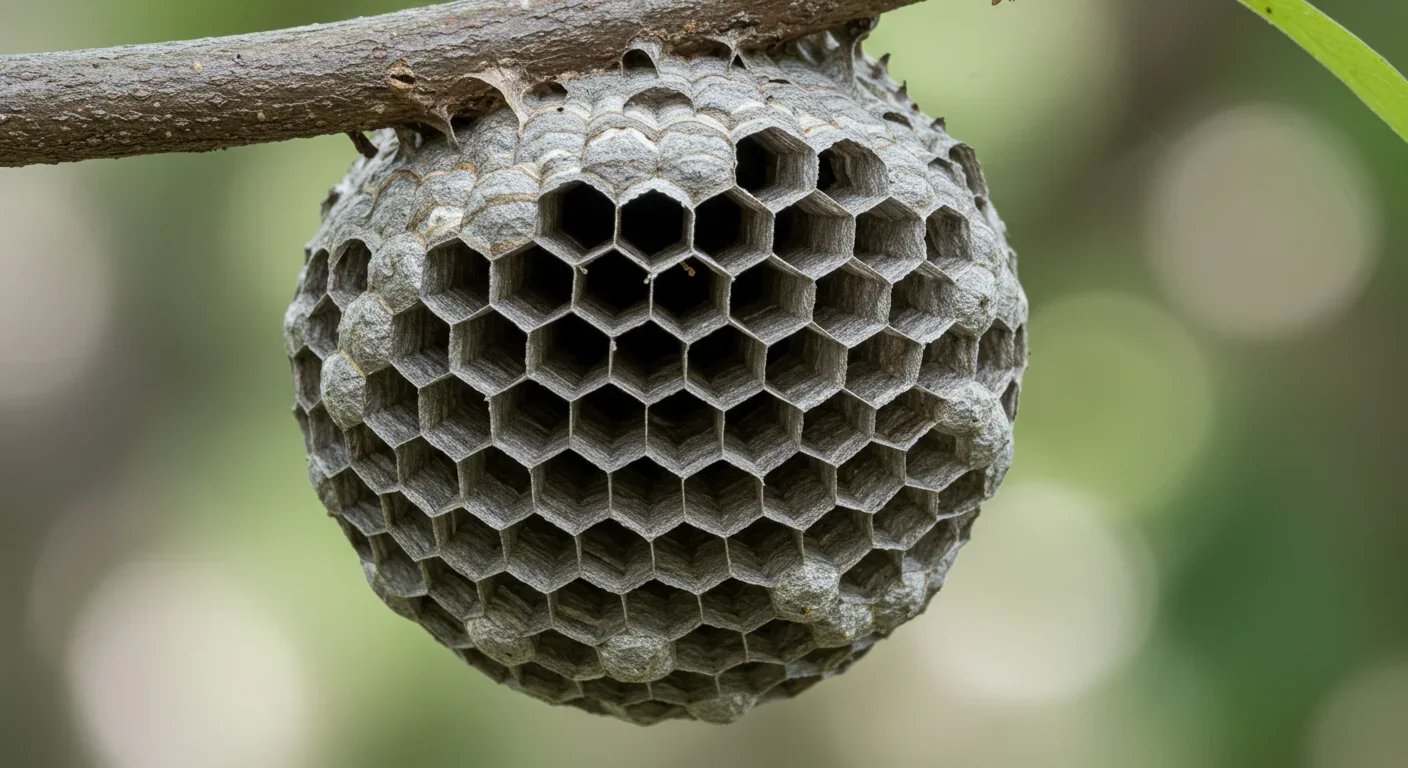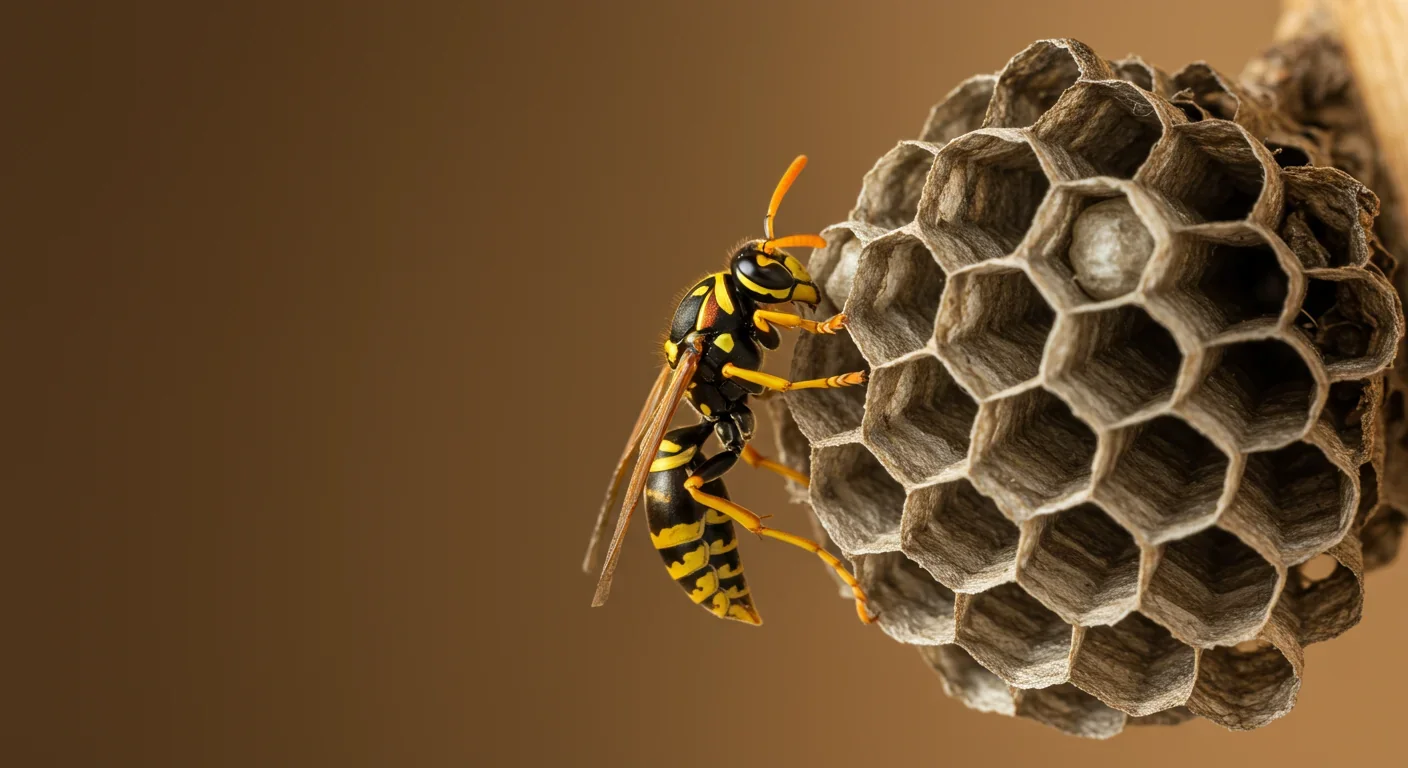Forest Biological Clocks: Ecosystems That Keep Time

TL;DR: Social wasps build architecturally sophisticated nests through stigmergy—indirect coordination via environmental cues. Thousands of workers create optimized hexagonal structures without blueprints or central control, offering insights for robotics, AI, and organizational design.

Here's something that should make any project manager nervous: thousands of workers, no foreman, no blueprints, no direct communication—yet they construct architectural marvels that would make human engineers jealous. Welcome to the world of social wasps, where organized chaos produces structures so precisely engineered they follow mathematical optimization principles we're still trying to fully understand.
Every spring, a lone wasp queen emerges from hibernation and begins one of nature's most fascinating construction projects. Within weeks, what starts as a single hexagonal cell transforms into an intricate nest housing hundreds or thousands of individuals. The catch? Nobody's in charge. There's no master plan, no construction meetings, no central coordination whatsoever. Instead, these insects rely on stigmergy—a mechanism of indirect coordination where workers respond to environmental cues left by previous workers rather than communicating directly.
The concept revolutionizes how we think about intelligence itself. French biologist Pierre-Paul Grassé coined the term in 1959 while studying termite colonies, observing that "the individual labour of each construction worker stimulates and guides the work of its neighbour." But it's in wasp nests where we see stigmergy's full architectural potential on display.
Walk up to a paper wasp nest hanging from your porch eave and you'll see something remarkable: perfectly hexagonal cells arranged in a circular pattern, each wall exactly the right thickness to support the structure while minimizing material use. Mathematical analysis confirms that hexagonal designs naturally minimize material consumption, making them the optimal geometry for nest construction. But here's the thing—no individual wasp knows this.
Each worker operates on surprisingly simple rules. A queen begins by chewing wood fibers from weathered surfaces, mixing them with saliva to create a papery pulp. She builds a petiole—a single stalk—and attaches the first hexagonal cell to its end. That initial cell becomes the template for everything that follows. When workers emerge, they don't receive instructions; they simply add cells adjacent to existing ones, maintaining the hexagonal pattern through local geometric constraints.
"Think of it as writing notes on a shared whiteboard that others can read and react to, but the notes are written in the language of the environment itself."
— Stigmergy researcher describing indirect coordination
A worker arrives at the nest, detects an incomplete edge, and adds material. That modification becomes a signal for the next worker, who sees a different incomplete edge and fills it in. The structure itself acts as both the communication medium and the construction plan.
This isn't abstract theory. Research on Polistes paper wasps shows that workers add cells laterally in hexagonal arrays, each cell surrounded by six others. The regularity emerges not from any individual's knowledge of geometry, but from the physical constraints of attaching spherical pulp balls to existing cell walls. Simple local rules yield elegant global patterns.

While the physical structure guides construction, chemical signals add another layer of coordination. Wasps communicate through pheromones—volatile compounds that convey information without direct contact. A queen emits pheromones throughout the nest that signal colony status and regulate worker behavior. Workers leave chemical traces as they move between nest sites during swarm founding events, creating trails that subsequent workers follow.
These aren't simple on-off signals. Different pheromone concentrations trigger different behaviors. High concentrations near the queen might inhibit construction in already-complete areas, while low concentrations at the nest periphery stimulate expansion. The nest becomes a three-dimensional chemical map, constantly updated by worker activity and environmental conditions.
What makes this coordination mechanism so powerful is its robustness. Remove a worker and the system continues functioning. Damage part of the nest and workers detect the disruption through changed chemical profiles and physical gaps, automatically redirecting construction efforts. There's no single point of failure because there's no central controller to fail.
The contrast with honeybees reveals convergent evolution: while bees use beeswax instead of chewed wood, both species independently evolved hexagonal packing—suggesting this geometry represents an optimal solution to efficient space utilization.
The contrast with honeybees is instructive. While bees also build hexagonal cells, they use beeswax secreted from abdominal glands rather than chewed wood. Both arrive at similar solutions through different materials and behaviors, suggesting that hexagonal packing represents a convergent evolutionary solution to efficient space utilization.
Not all wasp nests look alike, and the variation reveals how environmental pressures shape stigmergic processes. Paper wasps build umbrella-shaped nests with single-layer combs exposed to air, typically containing 25 to 100 workers. The open architecture provides ventilation and easy access but offers little protection from predators or weather.
Contrast that with yellowjackets, which construct elaborate multi-layered nests enclosed in a protective envelope. These colonies can reach 5,000 workers by late summer, requiring massive structures built inside cavities, underground, or within building walls. The envelope provides insulation and defense, created by workers depositing pulp in overlapping layers that harden into a paper-like shell.
Bald-faced hornets take this further, building football-sized aerial nests with multiple horizontal combs stacked inside a thick envelope. The architecture includes sophisticated thermoregulation features—air gaps between combs allow heat circulation, while the envelope's thickness varies to maintain optimal internal temperatures.
Then there's Synoeca septentrionalis, a swarm-founding species that builds massive nests with up to nine lobes spanning over three meters. These structures feature typically two entrance holes—unique within their genus—and are built flat against tree trunks at heights ranging from 1.7 to 6 meters. The swarm-founding process involves hundreds of workers arriving simultaneously at a construction site, coordinating through pheromone trails to establish the new nest within days.

Each architectural variant emerges from the same basic stigmergic principles applied under different environmental constraints. Ground-nesting yellowjackets respond to cavity dimensions; aerial hornets compensate for wind and temperature fluctuations; tropical Synoeca species account for heavy rainfall and intense sun. The building rules remain simple and local, but the resulting structures reflect precise adaptation to ecological niches.
Here's where things get genuinely surprising. Mathematical modeling reveals that wasp nest architecture follows optimization principles that would require sophisticated planning if humans attempted them. The hexagonal cell arrangement minimizes wall count for a given number of cells, reducing material and construction time. But it gets better.
Researchers have derived equations showing that the most efficient nest structure minimizes the number of exterior cells. A circular arrangement of hexagons achieves this naturally, which is exactly what we see in paper wasp nests. The shape isn't predetermined—it emerges from workers preferentially adding cells adjacent to existing ones rather than starting new peripheral rows.
Population dynamics models demonstrate how nest growth rates track environmental resource availability. Differential equations describing exponential and logistic colony expansion show that construction accelerates when food is abundant and slows during scarcity. Again, no central planner monitors food supplies and adjusts construction schedules. Individual workers simply reduce building activity when they're spending more time foraging and finding less food.
"The most efficient structure for a nest with n cells is the one for which w is minimized."
— Mathematical analysis of wasp nest geometry
The efficiency extends to material usage. A queen can construct the first few cells within 2-3 days. Once the first workers mature, the nest can double in size weekly during warm weather. This exponential growth emerges from positive feedback: more workers mean more construction capacity, which produces more cells, which house more larvae, which become more workers.
While field observations reveal stigmergy's results, experimental manipulations confirm the underlying mechanisms. Researchers have disrupted nests in controlled ways, observing how workers respond to artificial damage or rearranged components. The findings consistently show that workers react to local cues rather than following any global plan.
Remove cells from one section and workers preferentially build there, responding to the increased number of incomplete cell edges. Add artificial cells that violate the hexagonal pattern and workers adjust their construction to maintain local geometry, even if it creates slight irregularities in the overall structure. Introduce chemical markers that mimic pheromones and workers alter their building patterns accordingly.

The evolutionary advantages of stigmergic construction are substantial. Decentralization eliminates the vulnerability of hierarchical systems—there's no queen bee equivalent whose death halts all activity. The system scales efficiently from small founding nests to massive colonies. It adapts automatically to environmental variations without requiring complex cognitive abilities in individual workers.
Perhaps most importantly, stigmergy enables rapid innovation. Genetic variations that alter individual building rules can quickly propagate through populations if they improve nest functionality. A mutation causing workers to add slightly more pulp per cell might produce stronger structures that better withstand storms. Natural selection operates on emergent colony-level traits generated by individual-level behaviors.
The principles governing wasp construction have inspired a revolution in robotics and distributed systems. Swarm robotics applies stigmergic coordination to enable robot teams to accomplish complex tasks without centralized control. Early projects like the European SWARM-BOTS initiative demonstrated that 20 robots could collectively transport objects, cover areas, and search environments using only local communication and environmental cues.
Modern applications extend far beyond academic demonstrations. Warehouse robots coordinate package sorting by leaving digital "pheromone" trails that guide subsequent robots toward areas needing attention. Construction robots collaborate on building projects by responding to the current state of the structure, adding materials where incomplete sections signal a need. Agricultural drones survey fields in coordinated patterns that emerge from simple spacing rules and crop density feedback.
The appeal lies in robustness and scalability. Traditional robotics requires extensive programming to anticipate every scenario. Stigmergic systems handle unexpected situations gracefully because they're designed around local adaptation rather than global plans.
The appeal lies in robustness and scalability. Traditional robotics requires extensive programming to anticipate every scenario and coordinate every movement. Stigmergic systems handle unexpected situations gracefully because they're designed around local adaptation rather than global plans. Add more robots and the system automatically scales; remove some and the remainder compensate.
Antetic AI represents the cutting edge of this approach, using stigmergic principles to create distributed intelligence networks. Instead of building one massive AI system, developers create many simple agents that coordinate through environmental modification. The resulting collective behaviors exhibit intelligence that far exceeds any individual component's capabilities.
Think pheromone-inspired path planning for autonomous vehicles, where each car leaves a digital trace affecting subsequent routing decisions. Or stigmergic task allocation in distributed computing, where jobs gravitate toward available processors through virtual markers indicating priority and difficulty. The applications multiply as engineers recognize that nature solved distributed coordination problems billions of years before we started thinking about them.

Wasp nests force us to reconsider what intelligence means. We typically associate intelligence with individual cognitive capacity—brains, neurons, reasoning ability. But a wasp colony exhibits intelligent behavior at the collective level despite individual workers having tiny brains and limited behavioral repertoires.
This challenges the assumption that complex problem-solving requires complex cognition. The nest represents a solution to multidimensional optimization problems: minimize material use, maximize structural strength, regulate temperature, defend against predators, scale with population growth. No individual wasp understands these problems, yet the colony solves them through stigmergic interaction.
The concept extends beyond insects. Bacterial colonies use stigmergic signaling to form complex structures like biofilms. Slime molds navigate mazes and build efficient networks connecting food sources through stigmergic chemical trails. Even human systems exhibit stigmergic properties—pedestrian paths emerge where foot traffic wears away grass, stock markets fluctuate based on traders responding to price changes others created, and Wikipedia grows through contributors editing articles others started.
Redefining agency from an individualistic framework to a collective perspective reveals intelligence as an emergent property of interaction rather than an individual attribute. This has profound implications for artificial intelligence development. Instead of trying to recreate human cognition in silicon, we might achieve intelligence through networks of simple interacting components—much like wasps achieve architecture through simple building rules.
The lessons from wasp stigmergy offer practical insights for human systems. Our construction projects rely heavily on centralized planning—architects create detailed blueprints, project managers coordinate workers, engineers specify every component. This works, but it's also brittle. Changes require redesign, coordination breakdowns halt progress, and complexity quickly becomes unmanageable.
Imagine construction systems incorporating stigmergic principles. 3D-printing robots respond to the current state of a building, adding material where sensors detect incomplete sections. The design emerges from local rules about structural requirements rather than predetermined specifications. Changes propagate naturally as robots adapt to modified constraints. The approach already exists in laboratory demonstrations; scaling to real-world applications remains the challenge.
Organizational design offers another application domain. Traditional companies feature hierarchical management structures with centralized decision-making. Information flows up through reporting chains; directives flow down. It works until it doesn't—hierarchy creates bottlenecks, delays decisions, and fails when key leaders depart.
Stigmergy suggests an alternative: create environments where workers' actions inform others automatically. Transparent project management tools where everyone sees current status and contributes where they identify needs. Decision-making authority distributed to those closest to the work, guided by shared principles rather than explicit coordination. Market mechanisms that allocate resources based on signals embedded in price and availability.
Some organizations already operate this way. Open-source software development exhibits strong stigmergic properties—programmers contribute to projects by seeing existing code's gaps and needs, coordinating through the code itself rather than central direction. Wikipedia's growth follows stigmergic patterns as editors respond to article quality and coverage gaps. Agile development methodologies incorporate stigmergic elements through visible task boards and self-organizing teams.
As we confront increasingly complex challenges—climate change, pandemic response, sustainable urbanization—the limitations of centralized planning become apparent. These problems span multiple scales, involve countless interacting variables, and evolve faster than hierarchical organizations can adapt. Maybe what we need isn't smarter central planners, but better stigmergic systems.
Consider pandemic response. Centralized public health directives struggle to account for local conditions, leading to one-size-fits-all policies that work poorly everywhere. A stigmergic approach might enable local communities to respond to their specific situations while remaining coordinated through shared information systems. Infection rates, hospital capacity, and economic impacts become environmental signals that guide behavior without requiring central micromanagement.
Climate adaptation faces similar challenges. Each region confronts unique vulnerabilities and opportunities, yet global coordination remains essential. Stigmergic frameworks could enable local innovation while maintaining collective progress toward emission reduction and resilience building. Carbon pricing creates economic signals; technology sharing platforms enable distributed innovation; monitoring networks provide real-time feedback that shapes behavior.
The key insight from wasp nests: you can achieve remarkable coordination without remarkable coordinators. Simple rules, local information, and environmental feedback can produce outcomes that appear intelligently designed while remaining radically decentralized.
The key insight from wasp nests is that you can achieve remarkable coordination without remarkable coordinators. Simple rules, local information, and environmental feedback can produce outcomes that appear intelligently designed while remaining radically decentralized. The question isn't whether stigmergic principles work—wasps prove they do. The question is whether we're wise enough to learn from them.
Next time you see a wasp nest, resist the urge to call the exterminator immediately. Take a moment to appreciate the architectural achievement it represents. Thousands of individuals, each following simple rules, collectively creating something none could build alone. No blueprints, no foreman, no meetings—just stigmergy in action.
That suspended globe of paper cells contains lessons about intelligence, organization, and the emergence of order from chaos. We're only beginning to understand what wasps have been practicing for millions of years. The future might belong not to those who plan best, but to those who create the conditions for stigmergy to flourish.
The wasps figured this out long ago. We're still catching up.

MOND proposes gravity changes at low accelerations, explaining galaxy rotation without dark matter. While it predicts thousands of galaxies correctly, it struggles with clusters and cosmology, keeping the dark matter debate alive.

Ultrafine pollution particles smaller than 100 nanometers can bypass the blood-brain barrier through the olfactory nerve and bloodstream, depositing in brain tissue where they trigger neuroinflammation linked to dementia and neurological disorders, yet remain completely unregulated by current air quality standards.

CAES stores excess renewable energy by compressing air in underground caverns, then releases it through turbines during peak demand. New advanced adiabatic systems achieve 70%+ efficiency, making this decades-old technology suddenly competitive for long-duration grid storage.

Our brains are hardwired to see patterns in randomness, causing the gambler's fallacy—the mistaken belief that past random events influence future probabilities. This cognitive bias costs people millions in casinos, investments, and daily decisions.

Forests operate as synchronized living systems with molecular clocks that coordinate metabolism from individual cells to entire ecosystems, creating rhythmic patterns that affect global carbon cycles and climate feedback loops.

Generation Z is the first cohort to come of age amid a polycrisis - interconnected global failures spanning climate, economy, democracy, and health. This cascading reality is fundamentally reshaping how young people think, plan their lives, and organize for change.

Zero-trust security eliminates implicit network trust by requiring continuous verification of every access request. Organizations are rapidly adopting this architecture to address cloud computing, remote work, and sophisticated threats that rendered perimeter defenses obsolete.